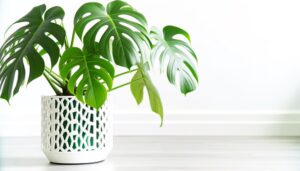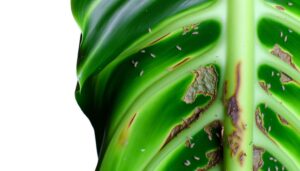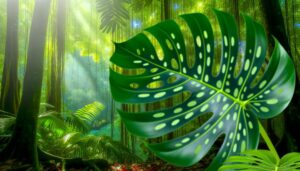Monstera Adansonii Vs Obliqua: Key Differences Explained!
Monstera Adansonii and Monstera Obliqua, both hailing from Central and South America’s tropical rainforests, differ starkly in leaf structure and growth patterns. Adansonii features thicker, heart-shaped leaves with frequent perforations, while Obliqua boasts paper-thin, delicate foliage with irregular fenestrations.
Adansonii climbs faster, making it more robust and easier to propagate. In contrast, Obliqua, with its trailing habit and rarity, commands a higher price and has more specific care needs.
Both thrive in high humidity and bright, indirect light. For a deeper understanding, look into their unique fenestration patterns and nuanced care requirements.
Key Differences Between Monstera Adansonii and Monstera Obliqua
| Feature | Monstera Adansonii | Monstera Obliqua |
|---|---|---|
| Leaf Structure | Thick, waxy leaves with distinct fenestrations (holes). | Very thin, delicate leaves with large fenestrations. |
| Leaf Size | Smaller, typically 6-12 inches long. | Larger, can reach up to 20 inches long. |
| Growth Rate | Faster growing, more common in cultivation. | Extremely slow growing, rare in cultivation. |
| Stem Thickness | Thicker, more robust stems. | Thinner, more fragile stems. |
| Habitat | Widely found in tropical forests of Central and South America. | Native to tropical regions, very rare in the wild. |
| Cultivation | Easier to grow and propagate, commonly available. | Difficult to grow, very rare in nurseries. |
| Price | Relatively affordable. | Extremely expensive due to rarity. |
| Watering Needs | Moderate watering, allowing soil to dry out between waterings. | Requires consistent moisture, very sensitive to drying out. |
| Humidity Requirements | Prefers high humidity but can adapt to lower levels. | Needs very high humidity to thrive. |
| Common Names | Swiss Cheese Plant, Five Holes Plant. | Often confused with Adansonii, no distinct common name. |
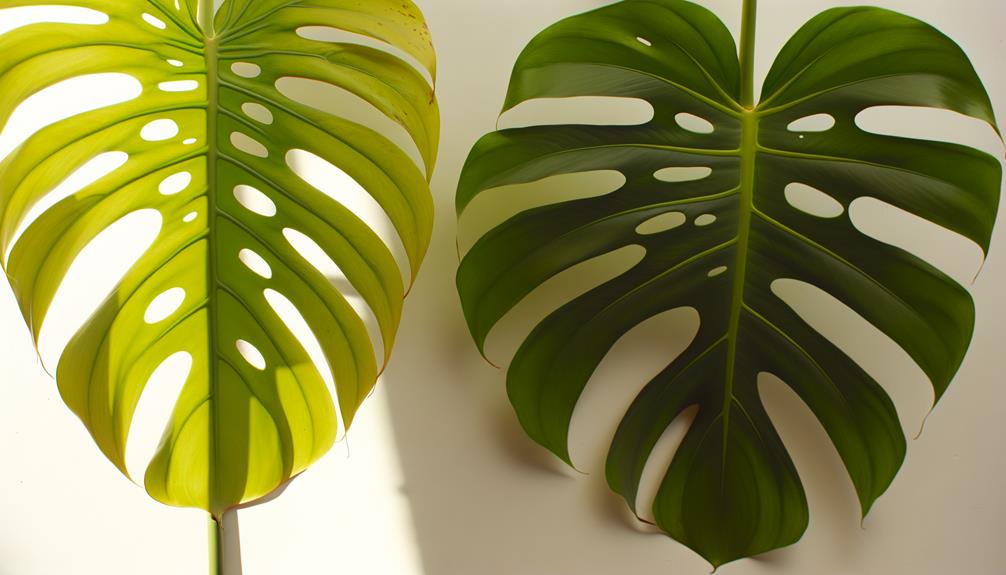
Origin and Habitat
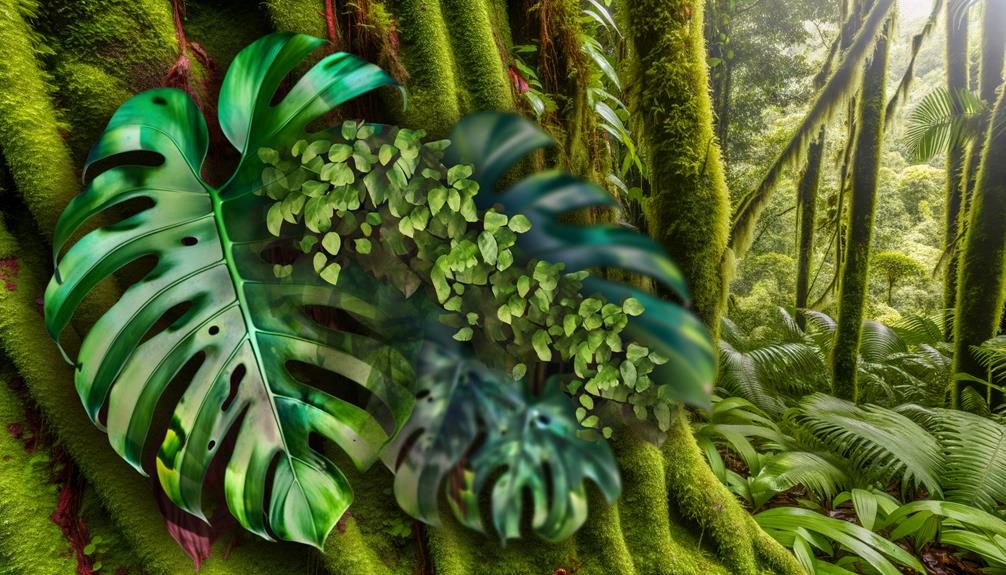
Both Monstera adansonii and Monstera obliqua originate from the tropical rainforests of Central and South America, where they thrive in the humid, shaded understory layers. You’ll find these species clinging to tree trunks and sprawling across the forest floor, benefiting from the dappled sunlight filtering through the dense canopy above.
Their epiphytic nature means they often grow on other plants, using aerial roots to absorb moisture and nutrients from the air and rain. The constant high humidity and warm temperatures of their native habitat are essential for their growth. These conditions foster a microenvironment that facilitates their unique adaptations, including their intricate leaf fenestrations and rapid growth.
Understanding their natural habitat helps you recreate best growing conditions at home.
Leaf Structure
When examining the leaf structure of Monstera Adansonii and Obliqua, you’ll notice distinct fenestration patterns and leaf shape differences.
Monstera Adansonii features smaller, more frequent perforations, while Obliqua exhibits larger, irregular holes that can occupy up to 90% of the leaf surface.
Additionally, Adansonii leaves are typically thicker and more robust compared to the delicate, paper-thin texture of Obliqua leaves.
Fenestration Patterns Comparison
Examining the fenestration patterns of Monstera adansonii and Monstera obliqua reveals significant differences in leaf structure, with adansonii exhibiting more consistent and smaller perforations compared to the highly fragmented and delicate fenestrations of obliqua. Adansonii’s leaves typically feature oval or elliptical holes that are uniformly distributed.
In contrast, obliqua’s leaves showcase extensive fenestration, with up to 90% of the leaf area composed of gaps, creating a lace-like fragility. Such differences are pivotal for identification and care.
| Aspect | Monstera adansonii | Monstera obliqua |
|---|---|---|
| Perforation Size | Smaller, consistent | Larger, highly variable |
| Distribution | Uniform | Irregular |
| Leaf Area | Less fenestrated | Highly fenestrated |
| Structure | Robust | Delicate |
| Identification | Easier due to uniformity | Challenging due to variability |
Understanding these patterns helps you distinguish between these two intriguing species.
Leaf Shape Differences
How do the leaf shapes of Monstera adansonii and Monstera obliqua differ regarding overall structure and morphology?
First, Monstera adansonii leaves are generally thicker and more substantial, featuring an elongated heart shape. In contrast, Monstera obliqua leaves are incredibly delicate and thin, appearing almost papery.
Here are four key differences:
- Thickness: Adansonii leaves are robust, whereas Obliqua leaves are fragile.
- Fenestration: Adansonii exhibits fewer but larger holes; Obliqua has numerous, smaller perforations.
- Shape: Adansonii leaves are more heart-shaped, while Obliqua leaves have a more irregular, asymmetrical outline.
- Texture: Adansonii leaves have a firmer texture, whereas Obliqua leaves feel almost membranous.
Understanding these differences can help you correctly identify and care for each species.
Growth Patterns
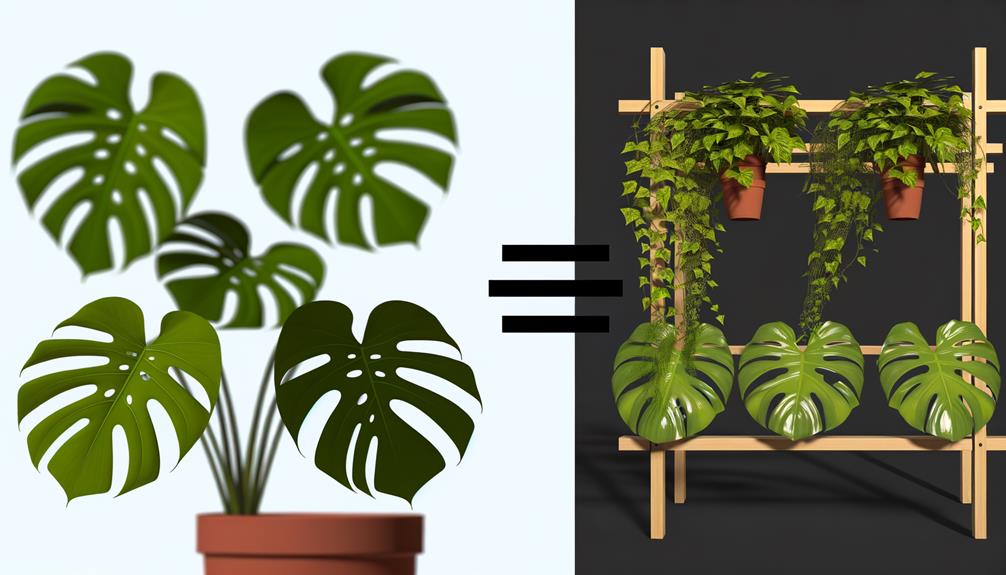
When comparing Monstera Adansonii and Obliqua, you’ll notice distinct growth patterns.
Adansonii typically showcases larger, heart-shaped leaves and favors a climbing habit, whereas Obliqua’s leaves are more delicate and it often trails.
Additionally, Adansonii grows at a faster rate, making it a more vigorous option for indoor gardeners.
Climbing Versus Trailing
Regarding growth patterns, Monstera Adansonii tends to exhibit more trailing behaviors, often cascading from hanging baskets or climbing nearby structures with its aerial roots. Whereas Monstera Obliqua is renowned for its exceptional climbing ability, adhering tightly to vertical supports as it ascends.
You’ll notice that Adansonii’s trailing nature makes it ideal for draping over shelves or hanging displays. It produces long vines that can be trained to climb but often prefer to spill over edges.
In contrast, Obliqua’s robust climbing mechanism utilizes specialized adhesive roots, allowing it to cling securely to surfaces. This species prefers vertical ascension, making it perfect for moss poles or trellises.
Understanding these distinct growth patterns helps you optimize their placement and care.
Growth Rate Differences
While both Monstera Adansonii and Obliqua showcase distinct climbing and trailing behaviors, their growth rates also significantly differ, with Adansonii typically outpacing Obliqua in foliage development and vine extension. Adansonii exhibits rapid growth due to its robust root system and efficient nutrient uptake.
In contrast, Obliqua’s growth is notably slower, a result of its delicate structure and higher humidity requirements.
Here are four key growth rate differences between these two species:
- Foliage Density: Adansonii develops denser foliage faster.
- Vine Length: Adansonii extends its vines more quickly.
- Root System: Adansonii has a more aggressive root growth.
- Environmental Adaptability: Adansonii adapts better to varying conditions, promoting quicker growth.
Understanding these differences helps you manage expectations and care for each plant effectively.
Care Requirements
Caring for Monstera Adansonii and Obliqua demands a nuanced understanding of their light, humidity, and watering needs to secure excellent growth and health.
Both species flourish in bright, indirect light but can tolerate low light conditions. They prefer high humidity, ideally around 60-80%, to replicate their native tropical environments. When it comes to watering, maintain the soil consistently moist but not waterlogged. Overwatering can lead to root rot, while underwatering can cause leaf browning.
Here’s a quick reference table for their care requirements:
| Aspect | Monstera Adansonii | Monstera Obliqua |
|---|---|---|
| Light | Bright, indirect light | Bright, indirect light |
| Humidity | 60-80% | 60-80% |
| Watering | Consistently moist soil | Consistently moist soil |
Propagation Methods
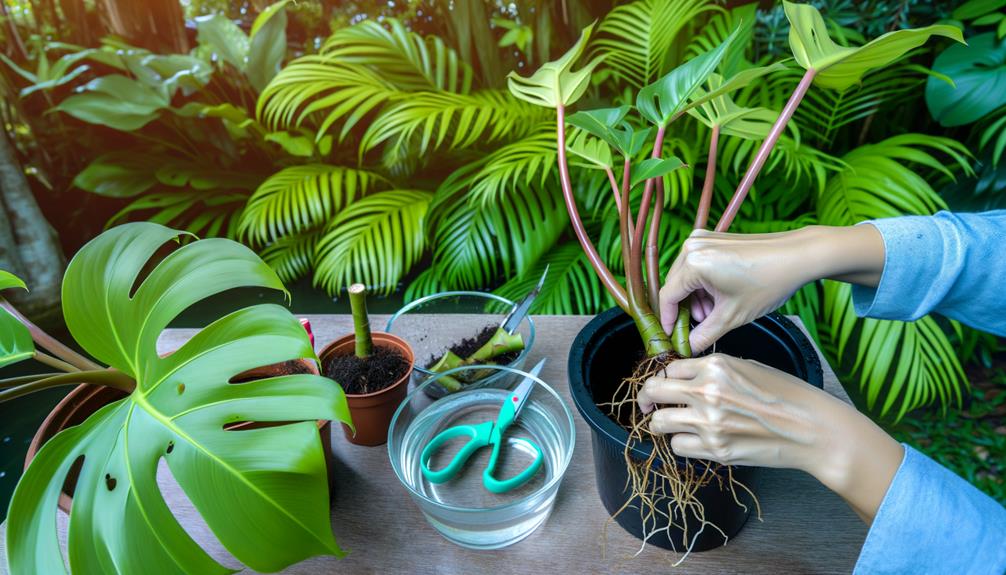
Propagating Monstera Adansonii and Obliqua involves using stem cuttings, a method that guarantees genetic consistency and robust growth when executed correctly.
Start by selecting a healthy stem with at least one node and an aerial root. Utilize disinfected pruning shears to make a clean cut below the node. Place the cutting in water or a well-draining soil mix to encourage root development.
Follow these steps for successful propagation:
- Choose a node with an aerial root for best nutrient absorption and stability.
- Disinfect cutting tools to prevent bacterial or fungal infections.
- Use rooting hormone to enhance root formation and vigor.
- Maintain high humidity around the cutting to mimic tropical conditions, essential for Monstera species’ growth.
Common Misidentifications
Identifying Monstera Adansonii and Obliqua can be challenging, as their similar fenestrated leaves often lead to frequent misidentifications among plant enthusiasts.
You might notice that Monstera Adansonii generally has thicker, more robust leaves with fewer, larger perforations. In contrast, Monstera Obliqua features extremely delicate, almost paper-thin leaves with numerous, smaller fenestrations, giving it a more lace-like appearance.
Misidentification often occurs because juvenile Monstera plants can exhibit varying leaf forms that mimic each other’s characteristics. Additionally, sellers sometimes mistakenly label Monstera Adansonii as Obliqua due to their visual resemblance and the latter’s rarity.
Paying close attention to leaf texture, fenestration patterns, and overall leaf morphology will help you differentiate these two fascinating species accurately.
Availability and Cost
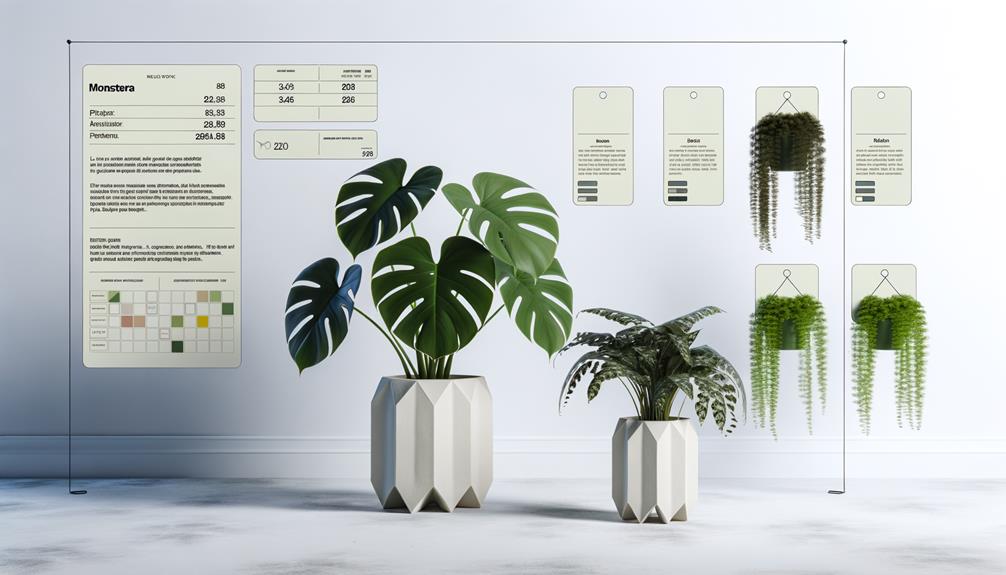
Due to its rarity and delicate nature, Monstera Obliqua commands a markedly higher price compared to the more commonly available Monstera Adansonii. You’ll often find Obliqua being sold for thousands of dollars, while Adansonii typically ranges from $20 to $50.
This stark difference is driven by several factors:
- Propagation Difficulty: Monstera Obliqua is notoriously challenging to propagate, requiring precise conditions.
- Growth Rate: Obliqua grows notably slower than Adansonii, making mature specimens scarce.
- Supply Chain: Obliqua’s fragile leaves and unique care requirements complicate transportation and handling.
- Market Demand: Collectors highly prize rare plants, driving up Obliqua’s value.
Understanding these factors helps you appreciate why Monstera Obliqua is such a covetable, high-cost plant.
Popularity and Rarity
Given the significant cost differences and the underlying reasons, it’s no surprise that Monstera Obliqua’s extreme rarity only amplifies its allure among plant enthusiasts and collectors.
This species is notoriously difficult to find due to its slow growth rate and specific habitat requirements. You’ll often hear it referred to as the ‘Holy Grail‘ of Monsteras.
The Adansonii, on the other hand, is readily available and more robust, making it a favorite for novice and seasoned growers alike. The scarcity of Obliqua results in its sky-high prices, often reaching thousands of dollars for a single cutting.
In contrast, Adansonii can be purchased at a fraction of the cost, making it a more accessible option for the average plant lover.
Conclusion
In choosing between Monstera adansonii and obliqua, you need to weigh their care requirements and availability.
While adansonii is more robust and easier to find, obliqua demands expertise and patience.
Imagine you’re nurturing an elaborate bonsai—obliqua’s fragile nature requires similar dedication.
Evidence shows that with ideal humidity and light, obliqua flourishes, but its scarcity and high cost make it a collector’s treasure.
Ultimately, your decision hinges on your gardening skills and commitment level.

